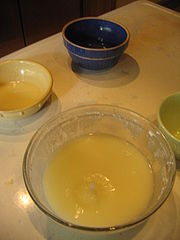- Whey
-
Whey, sweet, fluid 
Whey collecting as newly made cheese drains Nutritional value per 100 g (3.5 oz) Energy 112 kJ (27 kcal) Carbohydrates 5.14 g Fat 0.36 g Protein 0.846 g Calcium 47 mg (5%) Percentages are relative to US recommendations for adults. Whey or Milk Serum is the liquid remaining after milk has been curdled and strained. It is a by-product of the manufacture of cheese or casein and has several commercial uses. Sweet whey is manufactured during the making of rennet types of hard cheese like cheddar or Swiss cheese. Acid whey (also known as "sour whey") is obtained during the making of acid types of cheese such as cottage cheese.
Contents
Production
Whey is a co-product of cheese production. It is one of the components that separate from milk after curdling, when rennet or an edible acidic substance is added.
Uses
Whey is used to produce ricotta, brown cheeses, Messmör/Prim, and many other products for human consumption. It is also an additive in many processed foods, including breads, crackers, and commercial pastry, and in animal feed. Whey proteins consist primarily of α-lactalbumin and β-lactoglobulin. Depending on the method of manufacture, whey may also contain glycomacropeptides (GMP).
Whey protein (derived from whey) is often sold as a nutritional supplement. Such supplements are especially popular in the sport of bodybuilding. In Switzerland, where cheese production is an important industry, whey is used as the basis for a carbonated soft drink called Rivella. In Iceland, MS manufactures and sells liquid whey as Mysa in 1-liter cartons (energy 78 kJ or 18 kcal, calcium 121 mg, protein 0.4 g, carbohydrates 4.2 g, sodium 55 mg).[1]
Throughout history, whey was a popular drink in inns and coffee houses. When Joseph Priestley was at college at Daventry Academy 1752–1755, he records that, during the morning of Wednesday 22 May 1754, he “went with a large company to drink whey.”[2] This was probably ‘sack whey’ or ‘wine whey.’ A contemporary recipe for ‘wine whey’ instructs: “Put a pint of skimmed milk, and half a pint of white wine into a basin, let it stand a few minutes, then pour over it a pint of boiling water, let it stand a little, and the curd will gather in a lump, and settle to the bottom, then pour your whey into a China bowl, and put in a lump of sugar, a sprig of balm, or a slice of lemon.”[3]
An alternative recipe is for ‘Cream of Tartar Whey’: "Put a pint of blue milk [blue milk is characterized by the appearance on its surface, eighteen or twenty-four hours after it is drawn, of small, indigo-blue fungal spots that rapidly enlarge until the whole surface is covered with a blue film.] over the fire, when it begins to boil, put in two tea spoonfuls of cream of tartar, then take it off the fire, and let it stand till the curd settles to the bottom of the pan, then put it into a bason to cool, and drink it milk warm.”[4]
Whey was also used in central Spain to enrich bakery products. In some traditions, it was used instead of water to produce bread dough.
Whey cream and butter
Cream can be skimmed from whey. Whey cream is more salty, tangy, and “cheesy” than ("sweet") cream skimmed from milk, and can be used to make whey butter. Whey cream and butter are suitable for making butter-flavored food, as they have a stronger flavor of their own. They are also cheaper than sweet cream and butter.
Health
Because whey contains lactose, it should be avoided by those who are lactose intolerant. Dried whey, a very common food additive, contains more than 70% lactose.[5] When used as a food additive, whey can contribute to quantities of lactose far above the level of tolerance of most lactose-intolerant individuals.
Liquid whey contains lactose, vitamins, protein, and minerals, along with traces of fat. In 2005, researchers at Lund University in Sweden discovered that whey appears to stimulate insulin release, in type 2 diabetics.[6] Writing in the American Journal of Clinical Nutrition, they also discovered that whey supplements can help regulate and reduce spikes in blood sugar levels among people with type 2 diabetes by increasing insulin secretion.
Protein
Whey protein is the name of globular proteins that can be isolated from whey. It is typically a mixture of globinstagers beta-lactoglobulin (~65%), alpha-lactalbumin (~25%), and serum albumin (~8%), which are soluble in their native culture forms, independent of pH.
References
- ^ Mysa contents as cited on packaging from Mjólkursamsalan
- ^ Tony Rail and Beryl Thomas; Joseph Priestley’s Journal while at Daventry Academy, 1754, transcribed from the original shorthand; Enlightenment and Dissent (University of Wales, Aberystwyth), 1994, 13, 49–113.
- ^ Raffald, Elizabeth (1782), The Experienced English Housekeeper (8 ed.), R. Baldwin, p. 313
- ^ Elizabeth Raffald; The Experienced English Housekeeper; Eighth edition; London, R. Baldwin, 1782; p. 314.
- ^ Feedstuffs, National Research Council (U.S.). Subcommittee on Underutilized Resources as Animal (1983-08). Underutilized resources as animal feedstuffs. National Academies Press. p. 29. ISBN 9780309033824. http://books.google.com/books?id=atXqVe8fVXoC&pg=PA29. Retrieved 7 August 2011.
- ^ American Journal of Clinical Nutrition
External links
Categories:- Dairy products
- Milk
Wikimedia Foundation. 2010.

